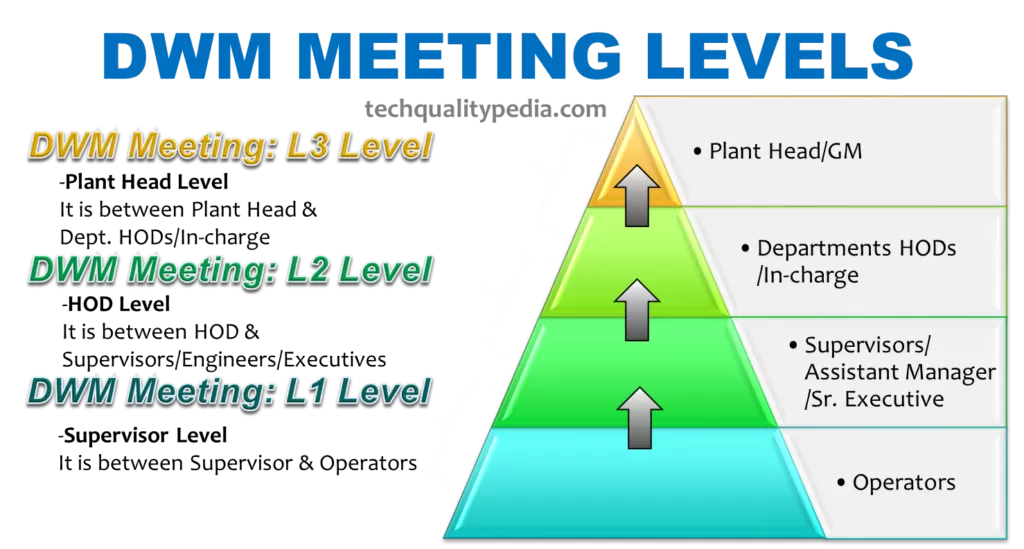Daily Work Management (DWM) is defined as the system that provides the ability to manage departments, functions, and processes, wherein processes are defined, standardized, controlled, and improved by the the process owners.
Daily Work Management or Nichijo Gemba Kanri is an important aspect of the KAIZEN journey and very useful tool of Lean Manufacturing. As we constantly say, the most important aspect in the success of a KAIZENjourney is “top management commitment.” When we think of top management commitment, two critical duties of leaders in every organisation come to mind:
- effectively and smoothly manage everyday operations
- strategize and execute activities to achieve organisational goals and vision
Or, to put it another way, we can divide these declarations into two initiatives:
- NichiJo Gemba Kanri (known as Daily Work Management)
- Hoshin Kanri (known as Policy Deployment)
Hoshin Kanri focuses on changes to be made in order to reach strategic goals through breakthrough KAIZENs, while Nichijo Kanri focuses on maintaining the improvements made along the way. Practicing Nichijo Gemba Kanri would reduce crisis management and firefighting situations, but practising Hoshin Kanri will ensure that the firm grows in the desired direction. In the KAIZEN perspective, Nichijo Gemba Kanri represents the SDCA (Standardize-Do-Check-Act) cycle, whereas Hoshin Kanri represents the PDCA (Plan-Do-Check-Act) cycle.
As a result, Nichijo Gemba Kanri is a requirement for Honshin Kanri.
Table of Contents
Why DWM?
Things do not stay there, they deteriorate. Can we have status Quo without improvement ? Answer is No. Therefore, small small but continual improvement is required to maintain the good condition of processes, machines & equipment etc. for business success.
Need for DWM
- No time for Improvement : DWM provides the platform for to work towards improvement activities.
- Always busy in fire fighting: Reduce fire fighting situation within & between the processes/departments.
- No Time Management- Improper division of time: Improve time management.
- To resolve daily work related issues.
- To reduce in between disturbance and unnecessary followup during the working day.
DWM ELEMENTS
- DWM SOP (Standard Operating Procedure)
- Data and Trend Charts
- Sunrise and Sunset meeting
- White Board (Person or Section wise task of the day)
DWM SOP includes the following points:
- Meeting Time (Sunrise and Sunset meeting).
- Purpose of DWM meeting
- Agenda of meeting
- Department and Venue
- Meeting Leader/Chairperson
- Team Members of DWM meeting
DWM MEETING LEVELS
DWM meeting conducted at 3 levels:

- DWM Meeting: L3 Level – Plant Head Level (It is between Plant Head & HODs).
- DWM Meeting: L2 Level – HODs Level (It is between HOD & Managers/Supervisors/Engineers/Executives).
- DWM Meeting: L1 Level – Supervisor Level (It is between Supervisor & Operator).
Discipline in Implementation of DWM system
Some key points for effective implementation of DWM system within the organization are:
- DWM meeting (Sunrise & Sunset meeting both ) starts on time.
- Meeting should be conducted as per the defined SOP.
- Chairperson/Leader should be in front of white board & all the attending person’s standing position in half circle in front of leader or white board.
- All the persons must carry their note book and other supporting data related to meeting agenda.
- All the persons come prepared for the meeting i.e. points of communication / discussion are written in their diary before coming to the meeting.
- Meeting outcome (person or depart wise wise task of the day) must be written on the white board.
- Each person also notes down the point related to their work….task of the day assigned to him / her.
- Sun set meeting must be conducted to verify the implementation of the sunrise meeting points.
Effectiveness of DWM System Implementation
How we come to know that the DWM system is effective…? When there are
- No in between disturbance during the day.
- No unnecessary follow ups during the day.
- No confusion in terms of priority of the day.
